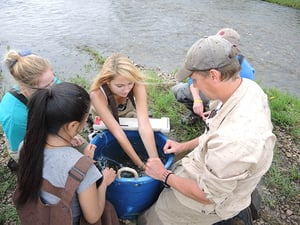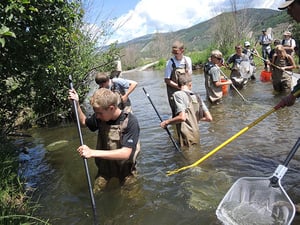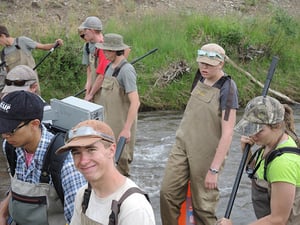Local High School Students Monitor Stream Health for the Forest Service
Contributed by Peter Wadden
Thanks to ongoing support from the National Forest Foundation and Vail Resorts’ Ski Conservation Fund, 12 local high school students participated in the third summer of the Walking Mountains Natural Resource Internship. The interns worked under the supervision of Matt Grove, fisheries biologist on the Eagle/Holy Cross Ranger District of the White River National Forest, to monitor stream and wetland health throughout the valley. The interns searched for endangered boreal toads to identify sites where they are still breeding in the area, but most of the students’ work focused on monitoring stream health.
 The interns learned two tried and true techniques for collecting information that helps the USFS gauge the health of waterways. The first was by collecting and measuring stream substrates. This involved plunging their hands into icy water to pull out rocks, pebbles, and gravel to be measured. The size of the stones in a stream dictates what aquatic insects can live there because those stones provide a place for the insects to hide and a surface to cling to in the rushing water.
The interns learned two tried and true techniques for collecting information that helps the USFS gauge the health of waterways. The first was by collecting and measuring stream substrates. This involved plunging their hands into icy water to pull out rocks, pebbles, and gravel to be measured. The size of the stones in a stream dictates what aquatic insects can live there because those stones provide a place for the insects to hide and a surface to cling to in the rushing water.
The second way the interns gathered valuable stream data was by collecting the macroinvertebrates themselves. What species of insects are living in a stream is a great indicator of how healthy that stream is. Some insects are tolerant of pollution while others are not. If only pollution-tolerant species are found, we can tell a stream may not be very clean. On the other hand, if insects that require clean, clear water to survive are found in abundance we will have strong evidence that the stream is doing well. Samples of insects were netted and collected by the interns in each stream they visited and then were preserved in ethanol to be sent to a lab for DNA identification.
The 12 Walking Mountains Interns mastered these data-collection techniques with training and supervision from US Forest Service fisheries biologists and seasonal fisheries technicians. In addition to providing valuable information to the US Forest Service the interns gained experience in field ecology and exposure to careers in science and natural resource management. The high school students also earned 4 environmental science credits from Colorado Mountain College, giving them a chance to connect their observations in nature to broader concepts in ecology and biology.
 The internship demanded a lot of time and energy from its participants. In addition to working 40 hours a week the interns had reading assignments, essays, homework, and tests. In spite of the commitment the students who participated appreciated the value of their work and its impact on the community. Kyle Jordan, who began his sophomore year at Eagle Valley High School this fall, said,
The internship demanded a lot of time and energy from its participants. In addition to working 40 hours a week the interns had reading assignments, essays, homework, and tests. In spite of the commitment the students who participated appreciated the value of their work and its impact on the community. Kyle Jordan, who began his sophomore year at Eagle Valley High School this fall, said,
“This internship has helped me gain important skills in field research to prepare me for future jobs. I’m excited for a new adventure each and every day. It has truly made my summer memorable.”
True to the model of programming offered by Walking Mountains Science Center, these high school students learned about environmental science both in the traditional sense and through hands-on experience. Concepts taught in the classroom were reinforced by observations in the field. Students often observed a pattern in the field before it came up in class, allowing them to effectively discover the concept for themselves. Isaac Yoder, a junior at Eagle Valley High School, recognizes the value of this type of learning saying, “through this internship I gained experience relevant to real life jobs and collected information that affects the community instead of just seeing it in a classroom.”








